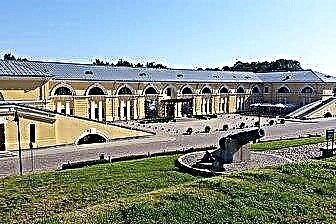Address: Russia, Yaroslavl region, Rostov region, Ishna village (Bogoslovo)
Build date: 1687 or 1689
Coordinates: 57 ° 10'49.1 "N 39 ° 21'14.6" E
Content:
Many people specially come to Rostov to see a rare example of Russian wooden architecture is a high church erected at the end of the 17th century on the Ishna River. In 2015, the church "turned" three hundred and thirty years old - the age for a wooden building is enormous. That is why this wonderful temple is so valuable. It has preserved all types of wooden decorations that were previously used by carpenters to give churches an elegant, festive look. And it turned out to be a real fabulous palace!
History of the Church of St. John the Evangelist on Ishna
From very ancient times, the crossing of the Ishna River belonged to the Epiphany Avraamiev Monastery. Next to it was the settlement of Bogoslovskoe, known since the 16th century. Earlier it was called the Ustretensky translation. And part of the ancient Rostov, adjacent to this place, is the Ustretenskaya side.

A road passed through the Theologian, along which it was possible to get from Rostov to Pereslavl-Zalessky and further to Moscow. And the monastery took a fee from those who crossed the Ishna River. Near this crossing in 1687 (according to other sources - in 1689), by order of the archimandrite of the Theological Monastery Gerasim, the temple in honor of John the Theologian was cut down. It was consecrated by the revered Rostov Metropolitan Jonah III Sysoevich.
The Christian tradition described in the Life of the Monk Abraham of Rostov is connected with the founding of this church. The text of the Life, according to experts, was compiled in the 15th century and is the only source about the life of the Russian saint. The events described in the medieval Life refer to the times when pagan traditions were still very strong in the Rostov land. And the locals worshiped several deities, highlighting and honoring Veles. Near Rostov there was even a stone idol dedicated to this pagan deity.
Abraham, who wanted to save the Rostovites from idolatry and bring them to the Christian faith, had a vision. A certain elder advised him to make a pilgrimage to Constantinople in order to strengthen his resolve there with prayers in the church of St. John the Theologian. Abraham set out on a long journey. But as soon as he left the city, near the river Inshi, the Apostle John the Theologian himself appeared to him and handed Abraham a staff, which later destroyed the idol of Veles. The very first wooden church was built at the place of the prophetic meeting, and Abraham became the founder of the Theological monastery, which was later named after him.
At the beginning of the 17th century, in the Time of Troubles, the church, like the surrounding village, was burned. And for several decades the place remained empty. According to the documents of that time, the settlement was designated as a village. That is, it did not have its own temple then. The new church was cut down only in the 80s of the 17th century. She has stood here to this day.

The theological church was active until the arrival of Soviet power. Its majestic appearance and beauty attracted many artists to these places. The famous Russian painter Vasily Vasilyevich Vereshchagin painted several of his paintings in the vicinity of the Theological Church. For example, the interior of a temple gulbisch is captured on the canvas “The porch of a rural church. Waiting for a confession. "
In 1913, when passing through Rostov to Kostroma to celebrate the 300th anniversary of the Romanov dynasty, Tsar Nicholas II and his family visited the temple. This visit is mentioned by a commemorative marble tablet fixed on the church wall. Also preserved are color photographs of the church itself and its iconostasis, taken in 1911 by the famous Russian photographer Sergei Mikhailovich Prokudin-Gorsky.
Architectural features and interior of the Church of St. John the Evangelist on Ishna
The picturesque church of St. John the Evangelist is a tiered wooden church, set on a high basement. Such lower floors were used in large mansion houses as living quarters, where servants or children were accommodated. And in churches, basements were used mainly for storage and household needs. Cellars or a storeroom with a treasury could be located here.
In the plan, the temple consists of a main square quadrangle and a refectory. But besides this, it has wooden annexes, which play a secondary role, but are connected with the main volume of the building. These are the so-called cuts. They are made from the east (altar) and from the west - on the vestibule, where the entrance to the church is located. Both cuts are crowned with an expressive figured roof in the form of a "barrel" traditional for those times, covered with an aspen ploughshare.
The middle quadrangle of the temple is high, as is the lower basement. An octagon is installed above its roof. And the upper, third tier - "felling" in its geometry has six faces and slightly expands upward. Above all, there is a dome and a drum, on which stands a bulbous cupola with a cross covered with a ploughshare.

There are many chopped and carved elements in the décor of the church - skates on the church roof, ceilings made of thin herringbone planks, as well as graceful carved columns. Decorative carved boards are installed above and below the windows. In addition, the window openings are closed with specially designed shutters made of wood.
On the western and northern sides, the church is surrounded by hanging galleries-porches or gulbis, resting on cantilever logs released from the wall of the basement. For their illumination, the so-called trailing windows were made. Following the footprints left on the wall of the temple, it is noticeable that there was a similar gallery on the south side. But for some reason it was taken apart.
The bell tower building was built later, in the 19th century. In plan, it is square at the bottom and hexagonal at the top. For convenience, the bell tower was connected to the temple with a wooden walkway. It is believed that it was during the construction of the bell tower that the southern gallery of the church was dismantled, the temple itself was sheathed with boards, and other galleries-porches were reinforced from below with brick posts, fearing a possible tilt of the building.
Inside, the Theological Church is very light and spacious. The temple amazes with the richness of its decoration. Its walls are carved as carefully as if they were polished. The pine logs that make up them are skillfully and neatly fitted to each other, and the joints between them are hardly noticeable. A powerful wooden door made of thick boards, which has an intricate lock, has been preserved in the temple since ancient times. In front of the altar, on both sides of the solea, there are choirs decorated with wooden carvings.
Now in the altar part of the temple there are fragments of an ancient four-level tyablo iconostasis, decorated with bright ornamental painting. The icons that were in it, experts attribute to the XVI-XVIII centuries. A copy of the unique wooden Royal Doors, made in 1562 by the master carver, monk Isaiah, is installed nearby. This copy is valuable in itself, because it was carved by the Rostov master V.L. Nikolsky in the 80s of the XIX century.

And the original of the graceful old Royal Doors is now on display in the White Chamber, in the museum collection of the Rostov Kremlin. In Rostov, there is also an icon of the 18th century that used to belong to the church, which depicts the appearance of John the Theologian to the Monk Abraham. Along the perimeter of the main image, it depicts small-sized scenes illustrating the text of the Life of Abraham of Rostov.
Current state and working hours of the Church of St. John the Evangelist on Ishna
The church is perfectly visible from the Yaroslavl highway and from the railway. But it makes the strongest impression at close range. The houses of the village of Bogoslovo are far enough away from the church, so nothing interferes with its view from all sides.
From the outside, the wooden church looks majestic, strict and laconic.The area around it is surrounded by a low openwork wooden fence, fixed on brick posts. On the territory of the Yaroslavl Region, this is the only wooden religious building that has survived to this day since the 17th century.
Now the temple is inactive and is under the jurisdiction of the museum-reserve of the Rostov Kremlin. The church is protected as a monument of ancient Russian wooden architecture. Smoking and open fires are strictly prohibited near the building.
You can go inside the church from May to September, from 10.00 to 17.00, on any day except Wednesday. Services are held here only twice a year.
How to get to the Church of St. John the Evangelist on Ishna
The temple is located in the village of Ishna (Bogoslovo), 3 km south-west of Rostov the Great.
By car. The federal highway M8, connecting Moscow and Arkhangelsk, leads to Rostov the Great. From the capital to the city - 220 km, and from Yaroslavl - 55 km. Moving from Moscow along the Yaroslavl highway, you need to drive the right turn to the Rostov Kremlin and turn left to Shurskol and Zhoglovo. Then, after the railway crossing, turn right towards Bogoslovo. The journey by car from Rostov to the temple takes 10-15 minutes.

On your own by train and bus. It is convenient to get from the capital to Rostov by Yaroslavl express trains. They leave twice a day - at 8.20 and 16.20. The train goes to Rostov for about three hours. You can take a taxi from the city center to the church.











